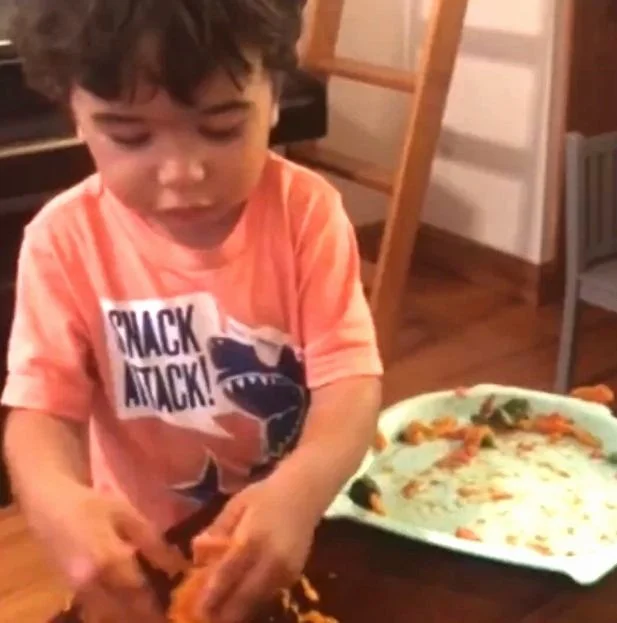Tips For Picky Eaters: Part 2
Surprise! There are so many more techniques and tips to try with picky eaters so here is part 2 with additional ideas for dealing with your picky eater. If you haven’t checked out part 1 yet, click here to read the full post.
As a reminder, don’t get caught up in comparison or perfectionism as a parent. There is no right or wrong way, but there are better ways.
I often joke with friends and family who have kids saying, “if my kid licks a piece of chicken tonight, then it’s a good meal.” Do you ever feel that way too? Just a little humor and to let you know that even as a dietitian, I am still a mom first and experience picky eater moments at mealtimes too.
We will conquer this together, and so that is why I am bringing you additional tips for dealing with picky eaters.
Don’t forget to get your free eBook with kid-approved recipes and parent tips here.
Here are 5 additional tips for picky eaters.
My son, Winston (2.5 yrs. old) pretending his sweet potato is playdough :)
1) Offering Overwhelming Portion Sizes
Let’s put things into perspective! For example, a serving size of protein for a toddler (2-3 yrs old) is 1-2 tablespoons of meat or beans. That portion size stays the same at 4-6 years old. It’s better to start at these age-appropriate portions and you can always provide additional servings if your child wants more! This avoids the anxiety your child may experience by seeing larger-than-life portions on their plate and feeling pressured to finish it all.
2) Snack-time
A snack that combines protein, fiber, and fat is going to help your kids feel full and it’s a great tip around snack time to avoid all-day grazing. Check out this post here about winning snack combinations.
Think of snacks as mini-meals, pairing at least two nutrients together to make a satisfying and filling snack. When time permits, make DIY snack bars like yogurt parfaits, a cereal bar, snack platters, anything where you can allow your kids to make their own winning snack combo.
Rid yourself of the thinking that you must make everything from scratch and it has to be super healthy. As busy parents, it’s ok to use store-bought snacks! Feel better already?? Just make sure to pair the snack with whole foods, for example, granola bar and cheese stick, cheese crackers and sliced pear, cerebelly bar (read more here about these bars) and applesauce. Here are more store-bought snack ideas for toddlers and here are more snack ideas for the whole family.
3) Involve Your Kids In The Decision-making Process
Encourages fun and experimentation! Allow for age-appropriate tasks in the kitchen. Let them wash veggies, peel, chop, mash, and eventually make a whole meal themselves!!
Let your kids write out or contribute to the grocery list. This is a great thing to do if they don’t like a particular meal one day. You can say, “what meal would you like next time?” Proceed to write up a grocery list together. Better yet, bring them along to the grocery store and let them pick out new fruits and veggies they want to try this week.
Give kids choices! Give two choices, both being things you are ok with, like “would you like a cerebelly bar and applesauce or a cheese stick and crackers for your snack?” Kids love making decisions on their own.
Some kids do better with foods not touching or things separate from each other. A great idea is to serve deconstructed meals and let your kids put things together themselves to avoid the battles over the chicken touching the rice. Think taco bar, loaded sweet potatoes, pasta bowls, and more. Their choice on how much!
4) Avoid Being A Food Cop
When parents say things like, “one more bite”, they override a child’s natural sense of fullness.
Monitor intake and look at the overall picture. Don’t get obsessed with making sure your child eats from every food group at every meal. Instead, look at their nutrition over the week. Perhaps they are more adventurous to try new foods at breakfast versus lunch. Take advantage of that observation and use it to try new foods. Notice patterns and timing and work it to your advantage.
Modeling - let kids see you eating all types of foods, even dessert! Try to avoid labeling foods as “good” and “bad” but rather explain how certain foods give you more energy to grow big and strong while others are more fun to eat occasionally.
If you do want to offer a treat, give it WITH dinner. This will avoid falling into the trap of using food as a “reward” for finishing their meal. This in turn places the dessert on a pedestal and is the reason why some kids feel out of control around these foods. It’s better to play it cool, serve it with the meal, and trust that your kids won’t only eat the dessert.
5) Understand Your Child's Development.
For example, from age 2-6 is when most kids may have neophobia, the fear of trying new foods. Knowing and understanding this will make you a more empathetic parent and can help you understand what is motivating their behavior around food.
Do an assessment - Assess where your child is at in their development, do you need to stop helping your child eat? Do you need to give them more freedom in the kitchen? Remember, we all go through phases with food and your kids are no different.
Let It Go!
Lastly, rid yourself of the high standards of super healthy meals all the time, comparisons, and feelings of inadequacy Give yourself and your child grace in the process and make it fun :)
Were you a picky eater or are you still one? Leave a comment.

